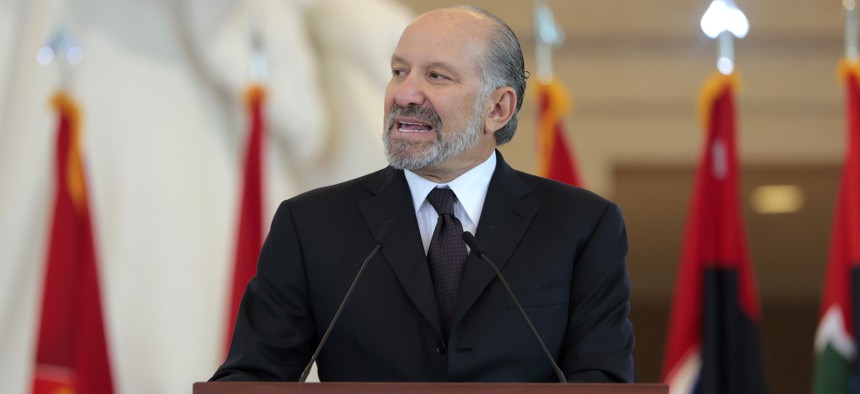BEAD uncertainty swirls, joined by Trump’s threats to the Digital Equity Act

Commerce Secretary Howard Lutnick speaks during an event last month. The futures of BEAD, and now the Digital Equity Act, remain in limbo. Anna Moneymaker via Getty Images
State leaders want more guidance from the federal government amid a 90-day delay in their final plans. President Donald Trump, meanwhile, said he will kill a related digital equity program.
Commerce Secretary Howard Lutnick’s review of the $42 billion federal program to expand broadband access is still underway, having started in early March. It appears that leaders at the state and federal level are getting antsy waiting for his verdict on its future.
And in a separate development, President Donald Trump pledged to “immediately” kill grants under the Digital Equity Act, calling it a “racist and illegal $2.5 billion giveaway.”
U.S. Sen. Shelley Moore Capito, a West Virginia Republican, sent Lutnick a letter earlier this month asking for a progress update on his review of the Broadband Equity, Access and Deployment program. Moore Capito said she is worried that the state might be asked to undo the progress it has already made, including reopening the subgrantee process to award the $1.2 billion it received from the federal government.
“Removing much of the red tape from the program in a timely manner, so that my state and all others could move forward even faster is an ideal outcome,” she wrote. “[I] am concerned that West Virginia may be told to move back from the 1-yard line to the 40-yard line after the review concludes.”
After Lutnick announced his review, the National Telecommunications and Information Administration, which helps administer BEAD and is still awaiting a permanent head, issued a notice in mid-April giving states a 90-day extension to submit their final plans.
State leaders, meanwhile, urged Lutnick and Congress to let them proceed with previously-approved plans. In separate open letters to NTIA and members of their federal delegation, various groups in Missouri urged progress on BEAD and said the state must be allowed to build fiber to help achieve the program’s goals. Spokespeople with the Department of Commerce did not respond to requests for comment.
Recent research suggests the digital divide is closing. An analysis of BEAD challenge process results — where governments, nonprofits or internet service providers could challenge whether a location is eligible for funding — showed a 57% reduction in unserved and underserved locations since 2023.
The Advanced Communications Law & Policy Institute at New York Law School said the findings raise “important questions” about the future of BEAD, as the data shows that other grant programs have helped reduce the digital divide, like those provided by the U.S. Department of Agriculture and the U.S. Treasury Department.
Researchers warned of the risk of overbuilding and said policymakers should avoid doing so as much as possible. And they said that states may have leftover money from BEAD given how the digital divide has closed already, so that funding should be reallocated to states that need more help.
And while some have suggested that satellite internet could play a larger role after Lutnick’s BEAD review, states should retain the flexibility to get people connected in the best way possible.
“States have more funding available to cover fewer locations, so they should be free to figure out how to deploy those funds, arguably in support of more terrestrial networks like fiber and maybe fixed wireless in certain areas and then narrowing the focus of satellite to just these really expensive, high-cost locations that exist in every state,” said Michael Santorelli, the institute’s director. “That could be a much more efficient way of allocating funding and making sure that more people get the benefit of a terrestrial broadband connection, then having satellites serve as a gap filler in those really hard to serve, incredibly expensive areas.”
Trump’s intervention in the Digital Equity Act might further complicate closing the digital divide, although it’s unclear how much he can do given that Congress has already appropriated the money. Lawmakers passed the Digital Equity Act as part of the 2021 bipartisan infrastructure law, which also funded BEAD, to provide grants to states to fund workforce development, education, health care and more, all with a view to closing the digital divide.
Trump called the program “unconstitutional” and called for an end to “woke handouts based on race.” U.S. Sen. Patty Murray, a Washington Democrat who first authored the Digital Equity Act in 2019, said Trump “has no idea what he’s talking about” and noted that cities, states and tribes all have “maximal flexibility” to decide how they spend those dollars.
“It is absolutely insane that resources meant to help red and blue communities — everyone from local school districts and libraries to workforce training programs and Tribes — close the digital divide will be illegally blocked because the President doesn’t like the word equity,” Murray said in a statement. “Americans are sick and tired of extremist right-wing culture wars being forced down our throats. Republicans will have to explain to their constituents why this Republican administration doesn’t believe their local library should get funding to help seniors navigate telehealth options or why middle schoolers in rural districts shouldn’t get laptops.”
Industry officials were similarly bemused by Trump’s Digital Equity Act pledge.
“The irony is that the weaponization of the word ‘equity’ will halt progress in closing the digital divide and will also severely impact his voter base of white Americans who live in rural areas in red states, including veterans and the elderly,” Alisa Valentin, broadband policy director at open internet advocacy group Public Knowledge, said in a statement.






